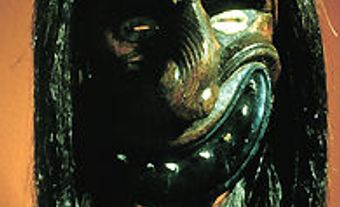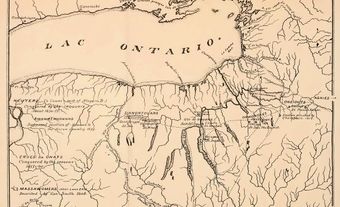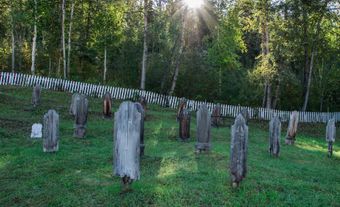Orthodox Church
Orthodox Church, also commonly known as the Eastern, Greek or Byzantine Church, a family of Christian churches historically found in eastern Europe, the Near East, Africa and Asia (see CHRISTIANITY). The 1991 census indicated that it served some 387 000 Canadians, although the total constituency claimed by the churches is higher.
Ancient History
The ancient patriarchal provinces of Rome, Constantinople, Alexandria, Antioch and Jerusalem were all established by the 5th century AD, but thereafter theological, liturgical and canonical divergence, as well as political differences, came between Rome and the other provinces.
The great schism of 1054 formally separated Rome (the Roman Catholic Church) from Constantinople and most of the population of the remaining 3 jurisdictions (the Orthodox Church). The issues leading to the schism, which still separate the Roman and Orthodox churches, include differences in trinitarian theology and church organization: the Orthodox churches dispute the Roman church's teachings on the Holy Spirit and the nature of authority in the church, specifically the primacy of the pope. The juridical ethos of Roman CATHOLICISM and Protestantism is perceived by the Orthodox as the central problem in Western Christian thought and institutions.
Present-Day Orthodox Church
The present-day Orthodox Church includes the ancient patriarchates of Constantinople, Alexandria, Antioch and Jerusalem; the "national" Orthodox churches of Russia, Serbia, Romania, Bulgaria, Cyprus, Greece, Albania, Poland, the Czech Republic and Slovakia; daughter churches of these, formed relatively recently in Europe and North America; and the autonomous churches of Sinai, Finland and Japan.
The unity of these "Byzantine" churches is theoretically found in their mutual recognition of a common faith and worship, rather than in any external authority or administrative structure. In practice, however, patriarchs of the various branches, though independent, tend to recognize the primacy of the Ecumenical Patriarch of Constantinople. A second group, the Oriental Orthodox (non-Chalcedonian) churches, includes the Armenian, Coptic, Syrian, Ethiopian and South Indian Orthodox churches. Members of this family who do not formally subscribe to the doctrine defining the dual nature of Christ as adopted by the Council of Chalcedon (451 AD) are nevertheless within the larger Orthodox family.
Orthodox Church Buildings
These are laid out to reveal the experience of God dwelling among men, and are patterned after the image of heaven in the Book of Revelation. The focal point is the Holy Table. An icon screen unites the sanctuary and the place of assembly. Everything which is in and of the church is considered "sacramental"; that is, manifesting the mystery of salvation and integrating the faithful into the life of the Kingdom of God. Among numerous rites and acts the Holy Mysteries are central: initiation through baptism (by triple immersion) and chrismation (anointing), the Eucharistic liturgy, marriage, monastic tonsure, reconciliation, anointing of the sick or dying, holy orders and burial.
Icons (religious images) are held to be necessary spiritual witnesses to the unity of the church through time and space, making present the Kingdom of God in the persons and presence of the saints. There are daily, weekly and yearly cycles of prayer and worship. The primary focus of the church year, which begins September 1, is Pascha (Easter); each Lord's Day (Sunday) is seen as the extension of Pascha.
Affiliations with Byzantine Tradition
Most Orthodox Christians in Canada are affiliated with churches of the Byzantine tradition: Russian, Greek, Antiochian, Ukrainian, Byelorussian, Estonian, Bulgarian, Serbian, Macedonian and Romanian. Although an earlier attempt was made to settle Orthodox Christians in Florida, the coming of Russian missionary monks among the Aleut peoples of Alaska in 1794 marked the real advent of Orthodoxy in North America. (The first Orthodox church in Canada may have been that at Wostok, Alta, established 1898.) A diocese centred on Sitka, established 1799, expanded into other parts of North America. In 1905 it became an archdiocese with headquarters in New York, amid successive waves of immigration from Russia, Carpatho-Russia, Ukraine and Byelorussia.
After the 1917 Russian Revolution, the Russian church came into conflict with the new communist government. In 1924 most Russian and associated parishes in North America declared their administrative independence, and a new metropolia, the Russian Church in America, was established. Its irregular and tense relationship with the mother church was resolved in 1970 when the Patriarch of Moscow and All Russia granted it autocephalous (self-governing) status. Now called the Orthodox Church in America, it affirmed the patriarch as its spiritual father, though remaining administratively independent. OCA's Canadian diocese serves some 20 000 adherents with 49 parishes and about 32 clergy. The Liturgy of St John Chrysostom is celebrated in Church Slavonic, Romanian, English or French. Some communities use the Julian (old-style) calendar, others the Gregorian (new-style) calendar. The church operates vigorous catechetical and mission programs.
Some Russian parishes chose to remain under the authority of the Patriarch of Moscow and All Russia. They are known as the Patriarchal parishes of the Russian Orthodox Church in Canada. Seventeen parishes in Alberta and Saskatchewan are served by 7 clergy, whose bishop is based in Edmonton. English has been introduced, but Church Slavonic remains the liturgical language. The remaining Russian Orthodox believers are part of the Russian Orthodox Church Outside Russia, formed 1920 in Yugoslavia by refugees of the Russian Revolution. Its headquarters are in New York. Conservative and monarchist, it has broken communion with canonical churches and supported other ethnic traditionalist groups. Its Canadian Diocese is administered from Montréal, with 25 parishes and several monastic sketes. Church Slavonic is the customary language of worship and the Julian liturgical calendar is used.
The Greek Orthodox Archdiocese of North and South America, the major daughter church of the church of Constantinople, has 74 Canadian parishes with a Toronto-based diocese which is a member of the CANADIAN COUNCIL OF CHURCHES. Substantial Greek immigration in the 1960s and 1970s has caused the membership to rise to over 250 000, served by 55 clergy. The principal language is Greek, and the church maintains strong links with Greek culture. The Gregorian calendar has been used since 1923, although 5 "Old Calendarist" parishes in Montréal and Toronto broke with the Greek church over its adoption of the revised calendar and involvement with the World Council of Churches.
The majority of Canadian Christians with Syrian, Lebanese and Palestinian ancestry are part of the Antiochian Orthodox Christian Archdiocese of North America, daughter of the patriarchate of Antioch (Damascus, Syria). A mission established 1892 by the Russian Orthodox Church, and another established 1914 by the Antiochian patriarchate for the Syrian immigration, were its seeds. They merged in 1936, and the present name was adopted in 1969. The Antiochian church, which maintains close links with OCA, has made a concerted effort to use English, which is now the principal liturgical language. Eleven parishes are scattered from PEI to Vancouver.
The Ukrainian Orthodox Church in Canada, formerly the Ukrainian Greek Orthodox Church, comprises 278 communities with about 140 000 parishioners. These are largely descendants of immigrants from Galicia, Ukraine, who settled on the Prairies from the turn of the century to 1929, and other Ukrainians who settled in Ontario cities after WWII. In 1932 the church established St Andrew's College, which affiliated with University of Manitoba in 1962. St Michael's parish at Gardenton, Man, the first Ukrainian church in Canada, is the site of an annual PILGRIMAGE.
Historically, Galicia was under the Ruthenian Rite of the Roman Catholic Church. Tension developed between the Canadian community and the Catholic hierarchy over the Galicians' historic right to have married clergy and to use the vernacular language in the liturgy. Oblate priests, sent into various parishes, raised fears among Galicians that they were being "westernized." In response the Ukrainian Greek Orthodox Brotherhood was formed in 1918, and led many Ukrainian Catholics into the Orthodox Church. A Syrian Antiochian Orthodox bishop assumed spiritual responsibility and ordained 3 priests. In 1951 the election of Ilarion Ohienko as metropolitan confirmed the church's autonomy. Metropolitan Ilarion, a noted Slavic linguist, translated the Bible into Ukrainian under the sponsorship of the British and Foreign Bible Society. The church's government is by consistory, a council of laymen and clergy, which is its highest authority. The liturgy is conducted mostly in vernacular Ukrainian. Consistent with its vision of itself as the bearer of Ukrainian culture, the church supports schools and folk groups, which form an integral part of community life. In 1990 the church entered into communion with the Ecumenical Patriarch and became a member of the Standing Council of Orthodox Bishops of the Americas.
The Ukrainian Orthodox Church of America (Ecumenical Patriarchate), organized 1928, has 4 parishes in Canada. It became a metropolia in 1983. The (Holy) Ukrainian Autocephalic Orthodox Church in Exile, with 2 Canadian parishes, is a body formed 1954 by clergy and laymen who fled Ukraine following its return to the Soviet sphere in 1944. The church traces its ecclesial origins to the Orthodox Church of Poland, which in 1924 received autocephalous status.
The Bulgarian Eastern Orthodox Church (Diocese of North and South America and Australia), begun as a mission of the Holy Synod of Sofia to Bulgarian and Macedonian immigrants in North America, became a metropolia following the Second World War. Ties with the Holy Synod were broken 1947-62 as the community debated its relationship to the mother church, which was under the communist umbrella. In 1962 some Bulgarians rejoined the mother church, but others condemned that action. At first organized under the Russian Church in Exile as the Bulgarian Orthodox Church, Diocese of the US and Canada, the dissidents merged with the OCA, with a diocese centred in Toledo, Ohio. The Patriarchal Church and the Russian Church in Exile each has one Bulgarian community in Canada. Complicating this situation is the Macedonian Orthodox Church, Diocese of America, Canada and Australia, administered from Toronto. Comprising Macedonians and Bulgarians, it is the result of the re-establishment of the ancient Macedonian see of Ohrid as an independent church along national lines.
Created in the 14th century, the Orthodox Church in Byelorussia has almost constantly struggled for autonomy from the patriarch at Moscow. Following the local government's 1946 alignment with Moscow, Byelorussians established churches in exile. In 1968 the diocese of the Byelorussian Autocephalic Orthodox Church based in Toronto received its first archbishop. There one church serves several missions in mid-Canada's industrial belt. A translation of the Divine Liturgy into Byelorussian has been prepared in Canada. In 1951 a Byelorussian church in Toronto became part of the canonical Byelorussian Orthodox Parishes under the jurisdiction of the Ecumenical Patriarch, who exercises his authority through the Greek archbishop of Toronto.
A similar struggle for autonomy has marked the history of the Estonian Orthodox Church, a national church since 1920. At various times it was under the Ecumenical Patriarch or the Patriarch of Moscow. When the USSR occupied Estonia in 1944, Archbishop Aleksander of Tallinn fled to Sweden and established the church in exile under the Patriarch of Constantinople. It was brought to Canada by Estonian immigrants after WWII. Parishes in Toronto, Montréal and Vancouver serve 1500 Estonians.
Serbian immigration began in the 1850s with settlements in BC. Communities on the prairies developed following the turn of the century and in the 1920s others were established around Hamilton, Ont. Initially, these were served by a Serbian Mission of the Russian Orthodox Church. With the re-establishment of the Holy Synod in Belgrade in 1921, North American churches were transferred to its jurisdiction and became the Serbian Orthodox Church in the US and Canada. Attempts to establish North America as a metropolia failed, and in 1963 the Holy Synod in Belgrade created 3 dioceses for the continent. The 17 Canadian churches are served by 12 clergymen. Church Slavonic is used and the Julian calendar observed. The Serbian Orthodox Free Diocese in the USA and Canada resulted from a schism in 1963, when the Church-National Assembly voted to retain a bishop suspended by the Holy Synod. The assembly declared its autonomy from the Yugoslavian church, arguing that it was dominated by the communist government. The Serbian communities maintain ties with several autocephalous churches, although some canonical bodies do not recognize them. There are 7 Canadian parishes. Shortly after the collapse of Yugoslavia the 2 Serbian jurisdictions were re-united.
The Romanians adopted Christianity in the 4th century, but a national church was not established until 1859; it became a Holy Synod in 1885. The first Romanian parishes in Canada were established about 1909 on the Prairies, among immigrants from the provinces of Bukovina and Transylvania. In 1930 the patriarchate established the Romanian Orthodox Missionary Episcopate in America, which became an archdiocese in 1973. Though autonomous, it maintains ties with the mother church in Bucharest. Canada's 20 parishes, located largely in the Prairie provinces, follow the Gregorian calendar and use Romanian in the liturgy. In 1951 many Romanians in North America rejected the bishop appointed by the church in Romania. The resulting schism led to the Romanian Orthodox Episcopate of America. Through the Ukrainian Orthodox Church of the US a bishop was consecrated, and in 1960 he placed the jurisdiction under the Russian Metropolia (later OCA). The episcopate's 13 Canadian churches in Ontario and the Prairie provinces use Romanian and English in their liturgy and follow the Gregorian calendar.
Oriental Orthodox Christians in Canada
These non-Chalcedonians are of Armenian, Coptic, Ethiopian, South Indian and Syrian origin. The Canadian diocese of the Armenian Church of North America (established 1898) is governed by an assembly of laymen and clergy who elect a primate for a 4-year term, and is a member of CCC. The church is under the patriarch of Etchmiadzin (Armenia), head of the Armenian Church, and historically linked to the patriarchates at Jerusalem and Constantinople. The Armenian community in Canada was established following WWI, and in the 1950s and 1960s a second immigration largely from Turkey, Egypt, Syria, Lebanon and Iran occurred. Eight Canadian parishes now serve 50 000 Armenians. The first parishes were established in St Catharines and Hamilton, Ont, followed by those in Toronto, Montréal, Ottawa, Edmonton and Vancouver. The Liturgy of St Basil is customarily celebrated in classical Armenian. The use of unleavened bread at communion reflects the influence of a brief union with the Roman church in the 13th and 14th centuries. Though the Armenians follow the Julian calendar, they continue the ancient form of celebrating the Christ's nativity as part of the feast of Epiphany.
Coptic Orthodox Church
This Diocese of North America was established 1961 to serve recent Egyptian immigrants, who settled principally in Montréal, Toronto, Kitchener and Ottawa. Followers of the Coptic Church of Ethiopia and the St Thomas Church of South India have joined in their liturgy. The Coptic Church traces its origin to the apostle Mark who, tradition claims, evangelized Egypt. The patriarchate of Alexandria was of great significance in the early church, ranking in importance with Rome and Jerusalem. The North American diocese functions directly under the Coptic patriarch. The Liturgy of St Basil is regularly celebrated using the ancient Coptic chant and modern Arabic with occasional English and French. The Canadian church has recently translated this liturgy. It also sponsors a quarterly publication, Coptologia Studia Coptica Orthodoxa, and holds membership in the CCC.
Syrian Orthodox Church of Antioch
The Syrian Orthodox Church of Antioch in the US and Canada (frequently termed "Jacobite" after 6th-century organizer Jacob Baradaeus) is part of the ancient Antiochian patriarchate in Damascus. Along with the Syrian Liturgy of St James, a distinctive aspect of piety is a rigorous private prayer life. The 2 churches in Canada, in Montréal and Toronto, serve Syrians who immigrated in the 1950s.
Other Orthodox Churches in Canada
Two additional bodies which regard themselves as Orthodox exist in Canada. The Evangelical Orthodox Church, Saskatoon Diocese, separated from an Evangelical Mennonite Brethren church and identified with similar movements in the US, initially as the New Covenant Apostolic Order. Members developed a PRESBYTERIAN form of government, adopted apostolic forms of ministry and developed liturgical worship. This movement formed the Evangelical Orthodox Church of America, a portion of which in 1987 joined the Antiochian Orthodox Church. The African Orthodox Church, of which the single Canadian parish was established in Sydney, NS, in 1921, developed as part of the movement of black self-consciousness early in the century. It accepts the teaching of the 7 ecumenical councils and conforms to standard Orthodox practice.
In addition to these, there developed in the 1970s a small Canadian Orthodox Church movement centred at the Monastery of all Saints of North America in Dewdney, BC. What began as a movement affiliated with the Old Calendarist churches in Greece became the Canadian Orthodox Church (an archdiocese of the Ukrainian Orthodox Church, Kiev) in 1994. The monastery has a publishing house, Synaxis Press, and publishes 2 theological journals. The Canadian Orthodox Church serves various parishes in western Canada and the United States. It rejects the use of the Gregorian calendar for the liturgical cycle of the church. The movement advocates "traditionalism" and the formation of a Canadian Orthodox Church which is not bound to a specific ethnic community.
Orthodox churches in Canada, while reflecting world Orthodoxy, have been affected by political activities and ethnic divisions in their regions of national origin. Some jurisdictions argue that such divisions contravene the canonical principle that the church be united, with all the faithful gathered around a common episcopate. Efforts are being made in North America to realize this principle. Although the churches in Canada continue to serve their historic constituency, the initial immigrants, they now face new generations whose linguistic and cultural formation has taken place entirely in Canada. Questions about liturgical language and practice and about the mission of the church in Canadian society form the agenda of today's church. See also CHRISTIANITY.

 Share on Facebook
Share on Facebook Share on X
Share on X Share by Email
Share by Email Share on Google Classroom
Share on Google Classroom


